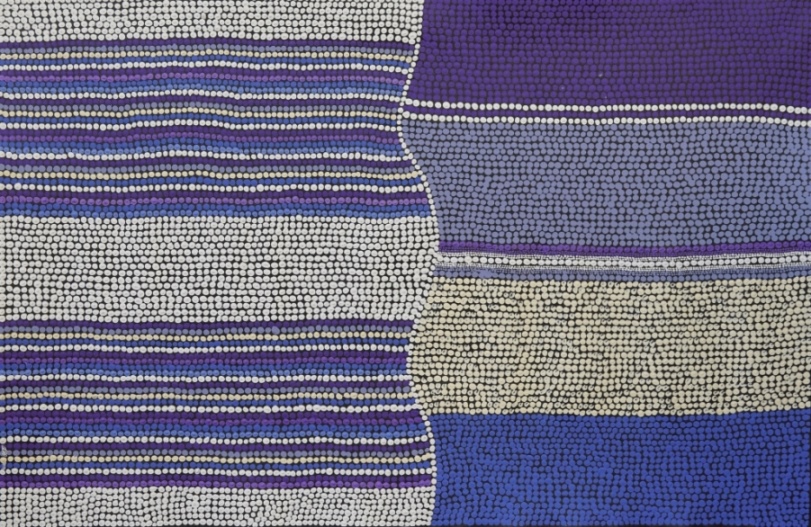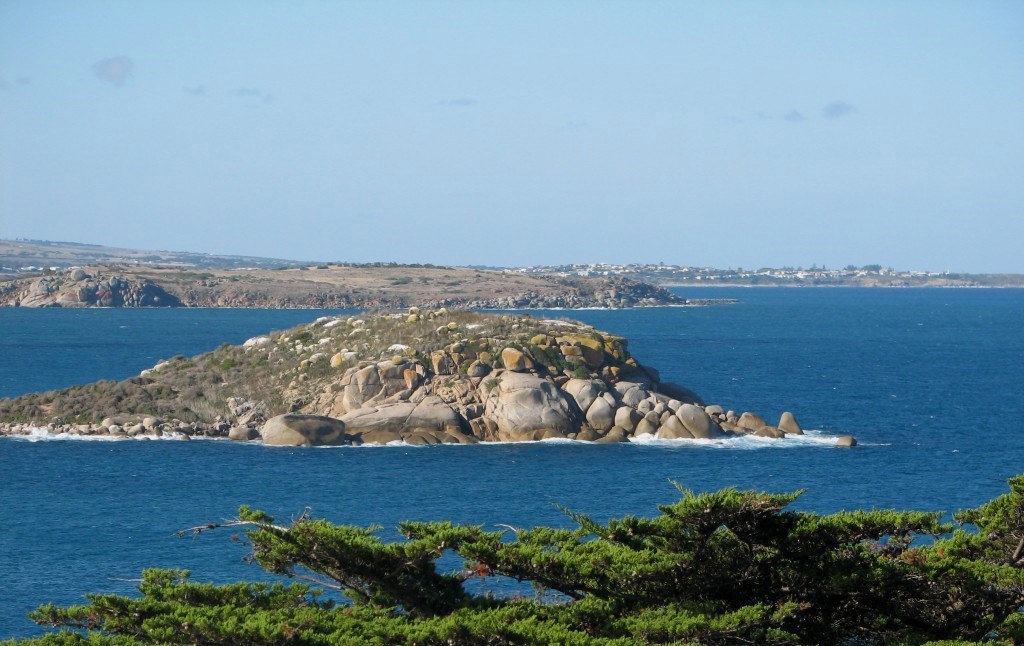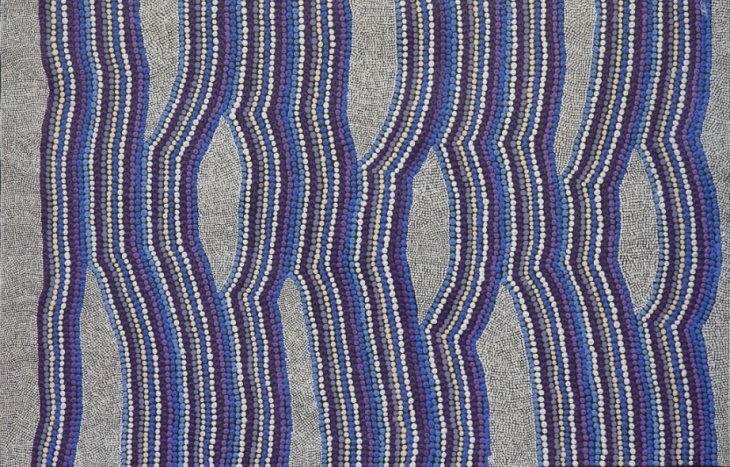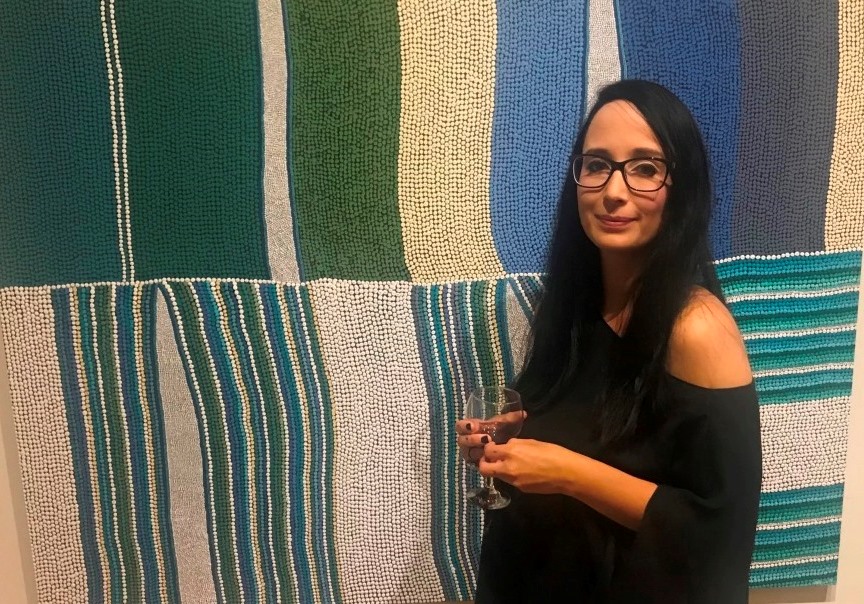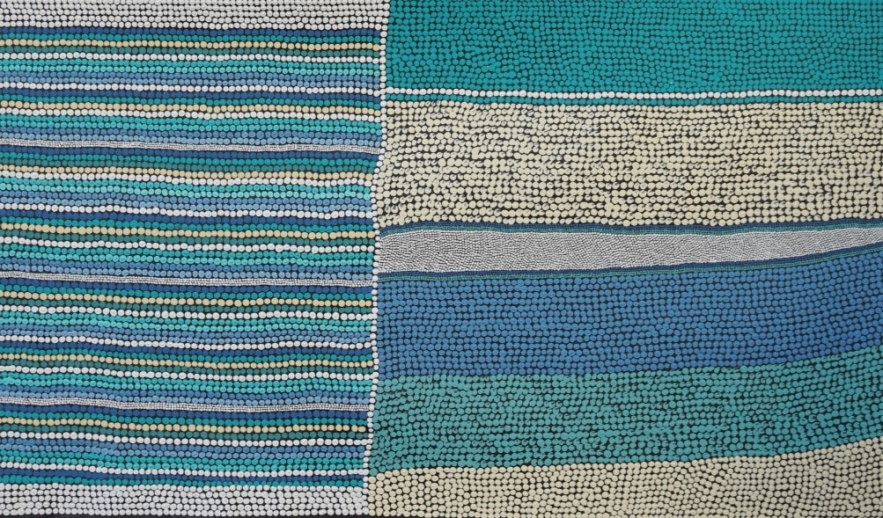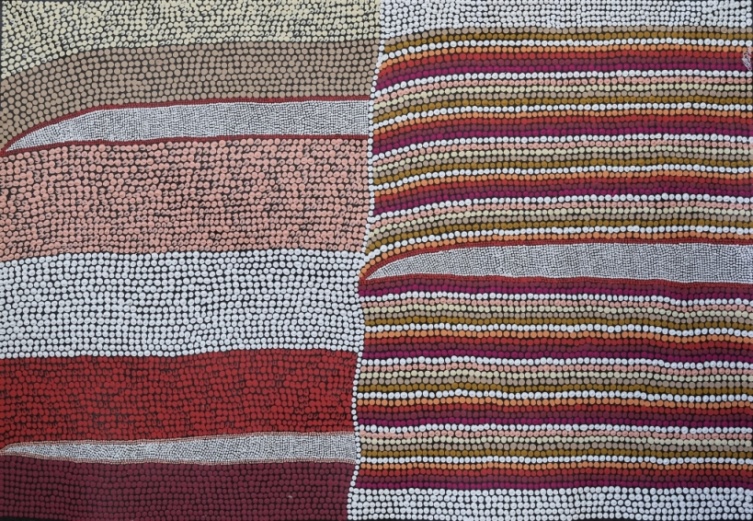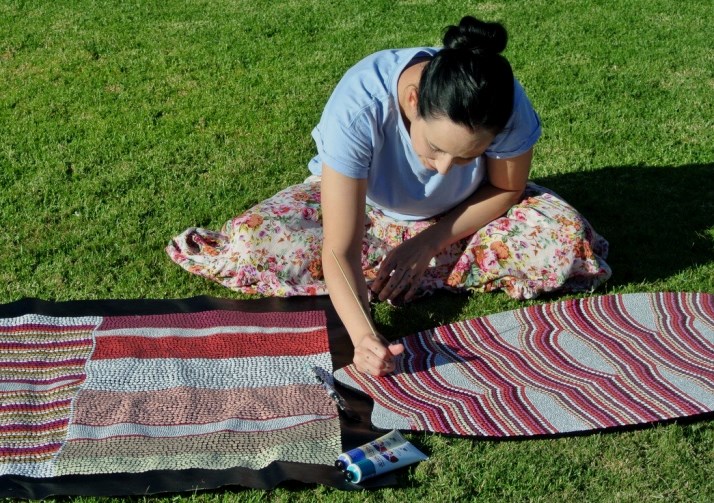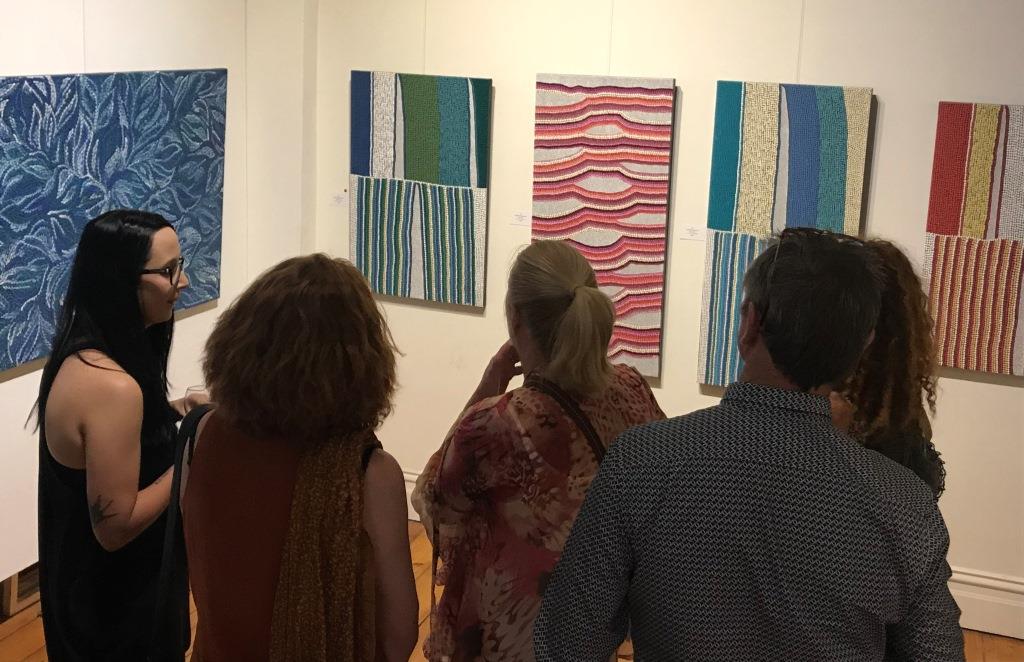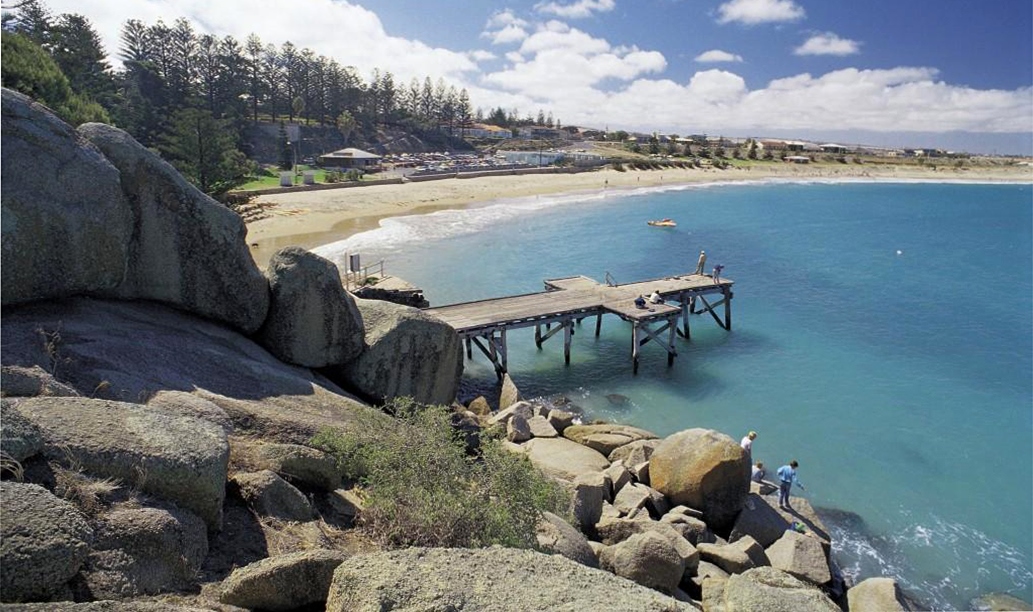Amanda Westley – The Painting of All of Me
Amanda Conway-Jones (nee Westley) is part of the Ngarrindjeri clan in South Australia. Here she talks about piecing her family history together, her art and her life in the coastal town of Victor Harbor. Amanda is talking on the day after the opening of her first solo exhibition.
Growing Up
Where did you grow up and can you describe what it was like?
I grew up in a little country coastal town Victor Harbor, in South Australia. We had a farm about 15 km out of Victor where we had vineyards. My Dad was a boat builder and a tuna fisherman, so I spent a lot of time on the water with him. My childhood was a mixture of coastal and country experience.
Finding Family History
Can you tell me a little bit about your clan and the history that you’ve been able to find out about them?
I found bits and pieces out about my family because when I was born, it wasn’t on my birth certificate that I was Aboriginal. I knew I had this passion for painting and this curiosity to find out more about my background. With Mum’s help, we went to get permission from elders with all the proper paperwork to show that I was Aboriginal. I have, over the years, gradually found out more and more out about my family. Interesting little facts. My great-grandfather had to become a Christian so that he could own land. I have members of the family who are elders and are helping to trace our history.
My grandmother is the youngest of fourteen kids. I think the youngest four were taken. Mum has shown me letters in this book that we have of her father writing to try to get the kids back. It says in the letters that he will pay a certain amount out of his monthly salary to get his children back. I find that interesting because that was printed in a book that we now have. Now everyone is all back together. My Grandma and her sister are now living back in Goolwa, at the mouth of the Murray River. The family is reunited and they’re all living just down the road, which is awesome.
When did you first take an interest in painting?
My mother went to Camp Coorong, which is the Ngarrindjeri culture centre, when I was very young. I have snippets of memory of her trying to find her Grandfather’s grave, an unmarked grave I believe. She went there to speak to the elders. I remember her talking about his artwork and I remember sitting down and helping paint, I think it was emu.
What was his art like?
I don’t remember much. I think it was very traditional. I’ve always compared my art to our traditional Ngarrindjeri art, and mine’s completely different. Theirs is very traditional.
First Painting
What was the first thing you painted?
I had a wardrobe in my room, and I opened one side of the door and painted the inside of the door first. Gradually I thought I was getting away with it because no one had said anything. Eventually, I covered the whole wardrobe. I stole some cork tiles from my Dad’s shed and painted those as well. Mum and Dad always supported my art, but it’s always been a very quiet thing. I’ve always just kept it to myself at home with my close family. Just Mum and Dad and my sister. I don’t even think that the rest of my family knew I painted. They were very surprised when I came out with some pieces when I was younger. They had no idea.
What made you decide to commit yourself to making art?
I’ve always found my artwork personal. I always struggled with the idea of someone purchasing my art and having it on their walls. I never thought of it as, “Ah, I love this piece that I’ve done. It’s amazing. I’d love to sell that, and I wonder if I could.” To me, the painting was just another part of me. I always kept it personal because I was worried about other people’s judgement of this other part of me.
The Role of Instagram
Eventually, I posted a few photos on Instagram on a personal page. I was invited me to be part of a group show with lots of other artists. It wasn’t a solo, I just put a few little pieces in and I got some good feedback, and that’s when I started thinking ‘Oh, maybe people might like it. It might be something that I should share with other people.’ It just grew from that little thing into more shows and more people asking to see my work. It is only in the last two years that I’ve started to get more serious enquiries and it’s started to blow up, which is fantastic. Japingka Gallery found me through Instagram.
Instagram’s gone crazy. It was the only type of sharing I could afford. I am a single mum. I moved back to Victor to look after my Dad who passed away from cancer. My marriage had ended, and I had two young kids and I couldn’t afford to do anything like setting up my own studio or a little space on my own. I didn’t have a house. I didn’t have a car. I didn’t have anything. I couldn’t afford to have a website or anything like that, so Instagram was it. I started just posting some pictures on Instagram, and it blew up from there.
Home Town Colours
Can you tell me about your paintings and what inspires them?
As a younger person growing up in my little hometown, I thought I wanted to move and be away from such a small community. I did for quite a while. I travelled around Australia. It wasn’t until Dad got sick that I moved back home. I realised that being home again, I appreciate where I lived.
My mum lives on two acres, so to me that’s a perfect little piece of country. It’s quiet, it’s out of the town. We live right near the beach. You can just drive down the road, and there’s a beach and I take the kids and the dog down to the beach most days. We’re the only ones on the beach. I think these Land Line paintings are just my story, how I see my land and how I appreciate where I’m from and where I live. If you come to my town, these are the colours you see. Whereas if you go anywhere else in Australia, they’re different colours, but these are my town colours, my country town colours.
You have a distinctive style. Is there anything you can tell me about how that evolved?
It’s changed from the beginning. If you look at my work from the beginning to now, I think my style is more mature now from when I started. Things have become more precise, I guess. My dots are more precise. Whereas my younger work it was more relaxed. I think I’ve changed since becoming a mother. I’m more organised and I feel like my art’s more organised. This is the style that I’m most happy with.
Where Painting Fits In
What your painting routine like at the moment?
It’s all over the place because I have two young kids. They like to watch me paint, so now and then during the day I can get a few hours in of painting. It’s not until I put the kids to bed that I can stay up all night and paint. It’s the only time I have to do it. Two days a week that I am kid-free because they’re both in school and child care.
Do you paint in silence or do you have sound?
When I’m on my own, I work in complete silence. I do sometimes start off with music, then I just turn it off eventually and sit there all day.
Are there personal stories that relate to each of the paintings?
Not traditional stories. Maybe they could be more like memories. For example, the waves ones are about being on the ocean with Dad. I guess they’re personal stories of us together fishing. Some of them are about me thinking of the farm that I grew up on.
Can you describe where you paint?
I would love to have that little studio spot, but I don’t. I have the kitchen table because we have a small place and there are the kids, and it’s just crazy. That room has a lot of natural light, glass doors and windows, which is great. Our kitchen table will be covered in paint and canvases. If the weather is good, I will go out the front of the house and sit there and paint on the grass.
The Painting Experience
How do you feel when you paint?
I stress a lot, I’m very anxious. I’m very uptight and impatient sort of person. I feel so very different when I’m painting. I call it therapy because I just sit there for hours. I never get bored and never get tired and never get sick of dots. I sit there for hours – eight hours non-stop would be a perfect day. I get up and get a coffee. I think about everything. I think of all the things that just pass through my mind, and I think I sort a lot of stuff out in my mind when I’m painting.
How do you feel at the end of the painting day?
I feel really good, and I go to bed and I think about it as well while I’m falling off to sleep. I think of the pattern, the colours that I used, and that’s how I come up with other paintings. I think of, “Oh, actually maybe if I use those colours,” and then something else is born from that.
Are there any artists that you find particularly inspiring? Do you have any favourites?
There are two artists that I follow on Instagram, and they’re very helpful. They’ve been painting a lot longer than I have and their artwork is a different style, but it’s still modern contemporary. There’s someone called Saltwater Dreamtime and his art is very surfy, ocean colours. And then there’s someone else, Otis he’s the same. Ocean colours and style. They’re both surfers. That’s why I feel like I relate a lot to them and their work inspires me. I’m always looking at their stuff and asking for advice and they’re very helpful. I just love their stuff. They’re very successful young Aboriginal artists. I look up to them.
First Solo Show
Can you describe what it was like to have this exhibition at Japingka Gallery? Is this your first solo exhibition?
Yes, it is. I was blown away when I walked in. I didn’t know what to expect because I’ve never been here. I didn’t know the area, I didn’t know what Aboriginal art is like up here, whether people appreciated it as much as other parts of Australia. So I didn’t know what this was going to be like at all. When I walked in, and I was made to feel so welcome. I haven’t seen these paintings framed and on a wall before. They were just flat and then rolled up and sent. So to see them all on frames, all next to each other, in one big room on white walls, it’s just amazing.
I’m very, very impressed that many people came along. They’re so lovely and open-minded. That’s what I like about people that come to art exhibitions or are artists. I feel like they’re very open-minded people and you can comfortably talk about whatever you want. They’ll talk about your painting or your background and they accept it. They are fascinated by it and they appreciate it too, which is great. When I walked in, there was a constant stream of people coming up and asking great questions. It was mind-blowing actually.
Acceptance
It’s one thing to paint art, and have it hanging and people don’t meet you. They just have this image of who the artist is if they’ve never seen a photo of you or don’t know who you are. I feel like people always expect me to be dark-skinned, so I used to like being able to paint and then hide behind my art. Being so openly-accepted as someone who has an Aboriginal heritage, but I don’t have the colour, I’m not dark, and people just being so okay with that. It’s just very comforting, and it just makes you think, “Oh, okay, well, maybe this is okay. People are happy, and they are going to accept me no matter what.” That’s a huge thing I struggled with. It’s awesome to come to somewhere where everyone’s just so excited to meet me.
What is it that you most want people to understand about your art?
There's more to the art than just pretty colours and patterns and shape. To me, it is my life. It is everything that has happened to me, like losing my Dad, becoming a single Mum, growing. I get upset talking about it. They all mean something very special to me.
I'm making it my own story. My whole life. My land, my kids, my life, all of it. Not so much my people's stories, but my stories.
View:
Amanda Westley - Colours of Ngarrindjeri Country (2022)
Read More:

